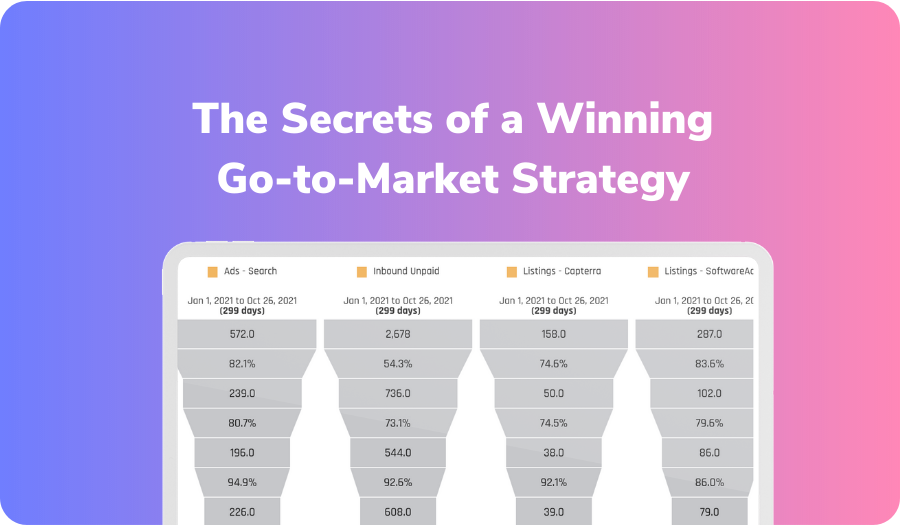How to Scale Your B2B Startup Faster With Go-to-Market Data
Every SaaS company wants to scale their business; few companies know how to do it effectively and efficiently. Scaling requires executive and...

Go-To-Market strategy is a crucial part of any business, as it helps organizations to reach their target customers and generate revenue. It involves an in depth analysis of the market conditions, customer preferences and competitor landscape before developing effective strategies for sales and marketing initiatives.
As Chief Revenue Officers are responsible for driving growth through successful GTM Strategies, they must be well versed with the basics around go to market strategy such as different tactics used by SaaS companies, B2B & B2C businesses; creating compelling pitch decks using technology & analytics; and crafting an effective go to market plan that will help them maximize ROI from their investments. In this article we'll explore all these aspects so you can create winning GTM strategies.
Crafting an effective go-to-market (GTM) strategy entails identifying the target audience, developing a value proposition and messaging that resonates with them, creating a unique selling point (USP), setting up the right infrastructure and tools, devising an efficient sales process, leveraging technology and software analytics/intelligence solutions to measure success through key performance indicators (KPIs), analyzing results regularly to make necessary adjustments.
The benefits of having an effective GTM strategy in place are manifold; it helps create clarity around your product offering so you can focus on getting it into customers’ hands quickly. It also allows you to better understand customer needs by allowing you to segment markets more effectively and tailor messaging accordingly. Additionally, it provides structure for tracking progress towards goals while giving insights into what strategies work best in different scenarios.
A comprehensive tactic for introducing products and services to the public, Go-To-Market Strategy offers substantial benefits to organizations. As such, it is important to understand the different types of strategies available in order to develop an effective GTM strategy that best suits your business needs.
Key Takeaway: Creating an effective GTM strategy is key to success. It helps identify target audiences, craft value propositions and messages, track progress, and measure success with KPIs. Leverage technology and analytics for best results.
Reaching the right audience and capitalizing on opportunities are integral components of any successful business, and go-to-market strategies can help facilitate this. Depending on the type of company, there are different types of go-to-market strategies that can be used.
Leading advisory firm, GTM Partners highlights 7 types of Go-to-Market Motions that are commonly employed by B2B SaaS companies:
1. Inbound-Led |
Driven by digital marketing programs focused on creating content that generates website traffic, converting that traffic into leads, and passing those leads onto a sales team to close the business or simply taking online orders. Well-known examples: HubSpot |
2. Outbound-Led |
Driven by coordinated cold outreach from sales people supported by marketing teams. Often used when average sale price is $50,000 and higher because of the expensive nature of this type of GTM strategy. Well-known examples: Terminus |
3. Product-Led |
Driven by digital marketing and PR focused on generating website traffic and converting that traffic in to free sign-ups, free trials, or 'freemium' subscriptions to a product. As usage grows and new features are needed, free subscriptions are converted into paying customers. Well-known examples: Slack, Notion, Lucid Software |
4. Channel-Led |
Driven by relationships with distribution partners, resellers, and agencies who are equipped and incentivized to sell products on your behalf. They would use their own Go-to-Market motion(s) to sell your product or service. Well-known examples: Microsoft Azure |
5. Event-Led |
Driven by high-quality events such in-person exclusive experiences, virtual events, roadshows, or trade-shows. Well-known examples: Pavilion |
6. Community-Led |
Driven by multiple companies joining forces around a movement or category with one shared big idea in common. This is a 'rising tide lifts all boats' strategy and usually involves industry experts, influencers, and well-known customer advocates collaborating with brands to drive attention to a particular way of doing business and to the vendors that approach possible. Well-known examples: Atlassian (Jira) |
7. Ecosystem-Led |
Driven by integration marketplaces. Well-known examples: dbt, Mindbody |
Key Takeaway: Keep in mind, while most startups begin by mastering ONE motion, most companies combine multiple types of GTM motions to grow their revenue. For example, HubSpot initially grew through inbound marketing, but as they've expanded their GTM motion has expanded into product-led, outbound, channels, events, and ecosystems.
Crafting an effective Go-to-Market Strategy and determining which path to choose starts by answering some questions about your business. Here are three to get you started:
Your target market demographics and persona types may drive which Go-to-Market Strategy you choose. Marketing and sales people are the most active users of LinkedIn, so if you sell to them you'll likely employ an inbound-led approach with emphasis on producing content that your audience sees on LinkedIn. If you sell to Surgeons, LinkedIn is probably not the place you want to spend time and instead you'll likely have a sales-led outbound approach with reps making visits in the field.
If you sell to individual contributors and people trying to grow in their careers by learning from each other, creating an online community supported by virtual events may be the best play. If you sell software to home contractors who don't spend their days on a computer, community-led growth is unlikely to be an effective approach.
If you don't have anyone skilled at running events, you either need to hire someone or not focus on events until you have the right person on board.
Constructing a sound go-to-market strategy is indispensable for any organization that desires to prosper. Identifying your target audience and market segments is the first step in developing a strong GTM strategy. Determining the wants and needs of your target audience, along with how to best satisfy them through your product or service, is a critical step in building an effective GTM strategy. To do this effectively, it's helpful to segment customers into groups based on demographics such as age, gender, location, income level etc., psychographics such as lifestyle choices and interests etc., and behavior patterns such as purchase history or usage frequency. Once you have identified these key customer segments you can then develop tailored value propositions and messaging specifically designed to appeal to each one.
Developing a unique selling point (USP) is also critical when crafting an effective GTM strategy. A USP should differentiate your product from competitors' offerings by highlighting features that make it stand out in the marketplace - whether that’s faster delivery times or superior quality materials used in production for example. This will help attract potential customers while at the same time setting expectations of what they can expect from working with your company which should be clearly communicated throughout all marketing activities.
Having all the pieces of a GTM plan in place, it's time to spread them out across numerous channels, such as digital media sites like social networks and SEO. Setting up the right infrastructure tools like analytics software will help track performance metrics so that adjustments can be made if necessary over time in order to ensure maximum return on investment from any campaigns launched using this approach.
Crafting an effective go-to-market strategy requires careful consideration of target audience, value proposition, and messaging to ensure success. Implementing the right infrastructure and tools will be essential in ensuring a successful go-to-market launch that can then be measured through key performance indicators (KPIs).
Key Takeaway: Crafting an effective go-to-market strategy requires segmenting customers into groups, developing tailored value propositions and messaging to appeal to each one, creating a unique selling point that differentiates the product from competitors', and implementing the plan across multiple channels. This will ensure maximum ROI for any campaigns launched using this approach.
After choosing the best approach for your Go-to-Market Strategy, it's time to get to work on turning strategy into execution! Here are your next steps:
Map out all the critical process steps of how you'll reach prospects and turn them into customers. This usually involves using Lucid to build visual process workflows
Identify all the measurement points in that process and build a detailed financial model in Excel/Sheets.
Buy and configure your Go-to-Market technology (CRM, MAP, etc...) to measure every step of the GTM process so that you can manage with precision.
Make it easy on you and your team to visualize how your entire GTM motion is performing. How your people are performing, how effective are your channels, what are the conversion rates looking like throughout the process? That's the stuff you need to answer at the snap of a finger and you can't wait days or weeks for reports from a data analyst. That's what a tool like scaleMatters can help with.
As Chief Revenue Officers, success of a go-to-market strategy is paramount. To ensure its efficacy, the right infrastructure and tools must be put in place - outlining objectives, strategies, tactics, timeline and resources needed for implementation. Furthermore, an effective sales process should be established; this could involve lead generation activities such as cold calling or email campaigns to build customer relationships through personal interactions; understanding customer needs and pain points; creating proposals; negotiating contracts; closing deals successfully with account management post sale amongst other methods.
Technology has become increasingly important in today's market place when implementing a go-to-market strategy. Technology solutions like CRM software help streamline processes while providing visibility into pipeline activity with analytics reports.
Artificial intelligence (AI) can also be leveraged to automate tasks such as lead scoring or account segmentation so your team can focus on more high value work instead of mundane tasks. Having access to current info on competitors' prices and product specs is key for staying ahead in the market.
In conclusion, setting up the right infrastructure and tools along with utilizing technology solutions and AI will help create an effective sales process. Measuring success through KPIs allows teams to adjust their strategies accordingly over time, thus ensuring maximum ROI on investments made towards achieving desired outcomes from go-to-market strategies.
Key Takeaway: To ensure success, a comprehensive go-to-market strategy should include the right infrastructure and tools such as CRM software and AI automation to streamline processes. Utilizing technology solutions, real time data on competitors' activities and measuring KPIs are essential for achieving maximum ROI from investments in this area.
It is important for Chief Revenue Officers to understand the basics of a GTM strategy, different tactics available, how they differ between SaaS companies, B2B & B2C businesses as well as examples of successful frameworks. Additionally, CROs should leverage technology such as software solutions and analytics intelligence when creating effective go to market pitch decks. A solid understanding of these topics will help ensure success with your Go-To-Market Strategy initiatives.

Every SaaS company wants to scale their business; few companies know how to do it effectively and efficiently. Scaling requires executive and...

The data you capture in your go-to-market engine can be a competitive differentiator. When you take your data quality, data hygiene, and data...

It's common to think of data as just an operational component for sales and marketing teams. But did you know that the quality of your data can...